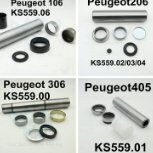-
Welcome to Auto Parts Forum
Whether you are a veteran automotive parts guru or just someone looking for some quick auto parts advice, register today and start a new topic in our forum. Registration is free and you can even sign up with social network platforms such as Facebook, X, and LinkedIn.
How To: Change Rear Differential Fluid
-
Similar Content
-
- 0 replies
- 51 views
-
- 0 replies
- 63 views
-
- 0 replies
- 102 views
-
- 0 replies
- 91 views
-
- 0 replies
- 88 views
-
-
Similar Topics
-
By Mia
Changing your brake pads is a manageable task if you have the right tools and follow the steps carefully to help you replace your brake pads: Tips
Always replace brake pads in pairs (both front or both rear) to ensure even braking. Dispose of the old brake pads and any other materials properly, following local regulations. Consult your vehicle’s manual for specific instructions and torque specifications. Welcome to learn more about brake pad types from here:
link hidden, please login to view 1. Tools and Materials Needed
Jack and Jack stands Lug wrench C-clamp or brake caliper tool Wrench or ratchet and socket set Brake pads Brake fluid Bungee cord or string Gloves and safety glasses Wheel chocks 2. Prepare the Vehicle
Park your vehicle on a flat surface and engage the parking brake. Place wheel chocks behind the rear wheels to prevent the car from rolling. 3. Raise the Vehicle
Use a jack to lift the car off the ground, and then place it securely on jack stands. 4. Remove the Wheel
Finish removing the lug nuts and take the wheel off to expose the brake assembly. 5. Remove the Brake Caliper
Locate the bolts on the back of the brake caliper and remove them using a wrench or ratchet. Carefully lift the caliper off the brake rotor. Use a bungee cord or string to hang the caliper from the suspension to avoid putting stress on the brake hose. 6. Remove the Old Brake Pads
Slide the old brake pads out of the caliper bracket. Take note of how they are positioned for proper installation of the new pads. 7. Inspect the Brake Rotor
Check the brake rotor for any signs of damage or excessive wear. If the rotor is in poor condition, it may need to be replaced or resurfaced. 8. Compress the Brake Caliper Piston
Use a C-clamp or brake caliper tool to slowly compress the caliper piston back into the caliper. This will make room for the new brake pads. Open the brake fluid reservoir cap to make this process easier. 9. Install the New Brake Pads
Place the new brake pads into the caliper bracket in the same position as the old ones. 10 Reattach the Brake Caliper
Carefully position the brake caliper over the new brake pads and rotor. Reinsert and tighten the caliper bolts securely. 11. Reinstall the Wheel
Put the wheel back on the hub and hand-tighten the lug nuts. 12. Lower the Vehicle
Carefully remove the jack stands and lower the vehicle back to the ground using the jack. 13. Tighten the Lug Nuts
Use the lug wrench to fully tighten the lug nuts in a star pattern to ensure even pressure. 14. Check the Brake Fluid
Check the brake fluid level in the reservoir and add fluid if necessary. Replace the reservoir cap. 15. Test the Brakes
Before driving, pump the brake pedal a few times to ensure the brakes are properly engaged and check for any leaks or issues. -
By austinbearing
Hello, everyone.We are an auto bearing manufacturer from China.
We produce Peugeot, Renault, Fiat and some other aut bearings.
Contact me if you're interested.
WhatsApp: +8613775640157
E-mail: [email protected]
-





Recommended Posts
Join the conversation
You can post now and register later. If you have an account, sign in now to post with your account.
Note: Your post will require moderator approval before it will be visible.